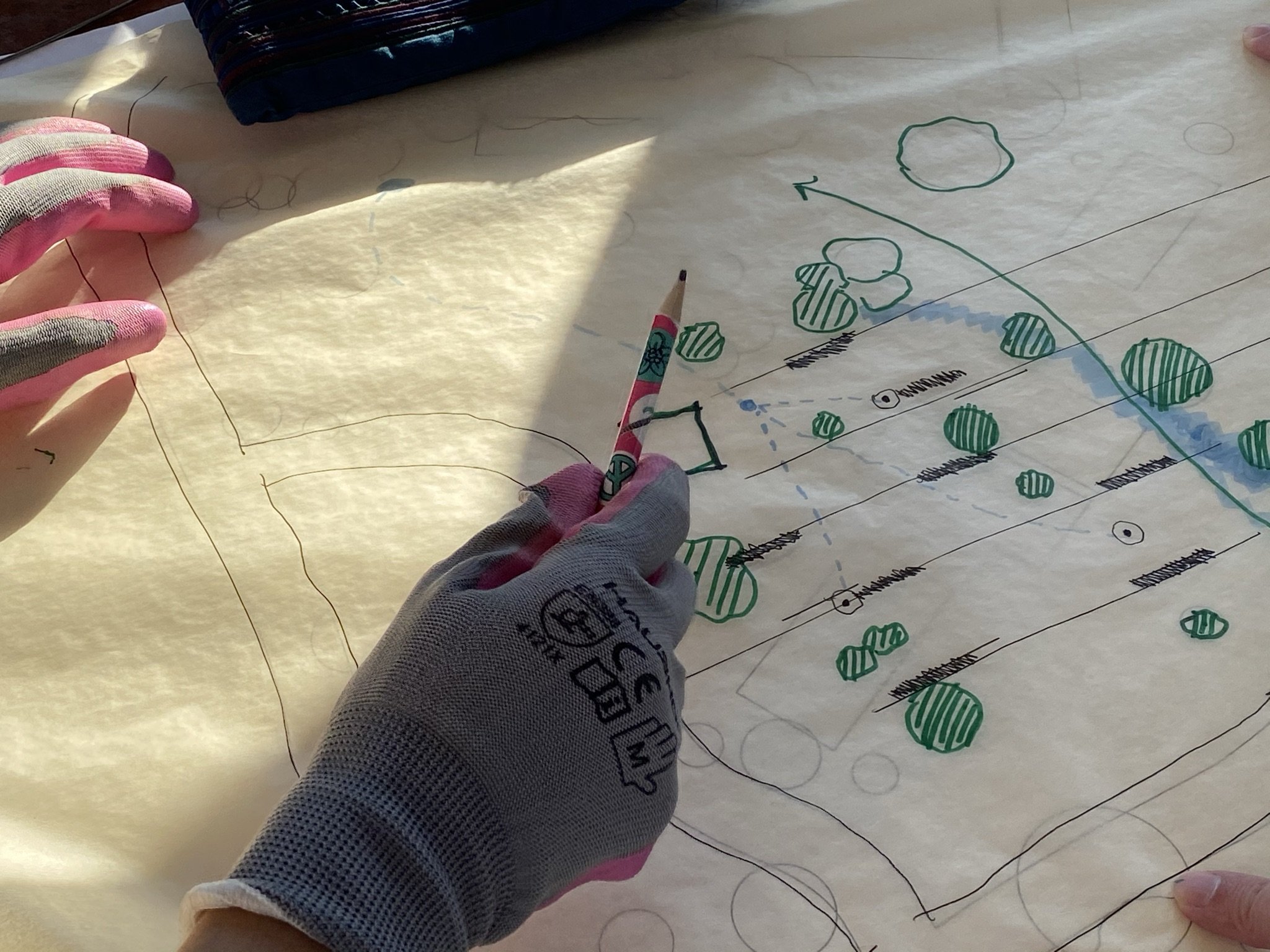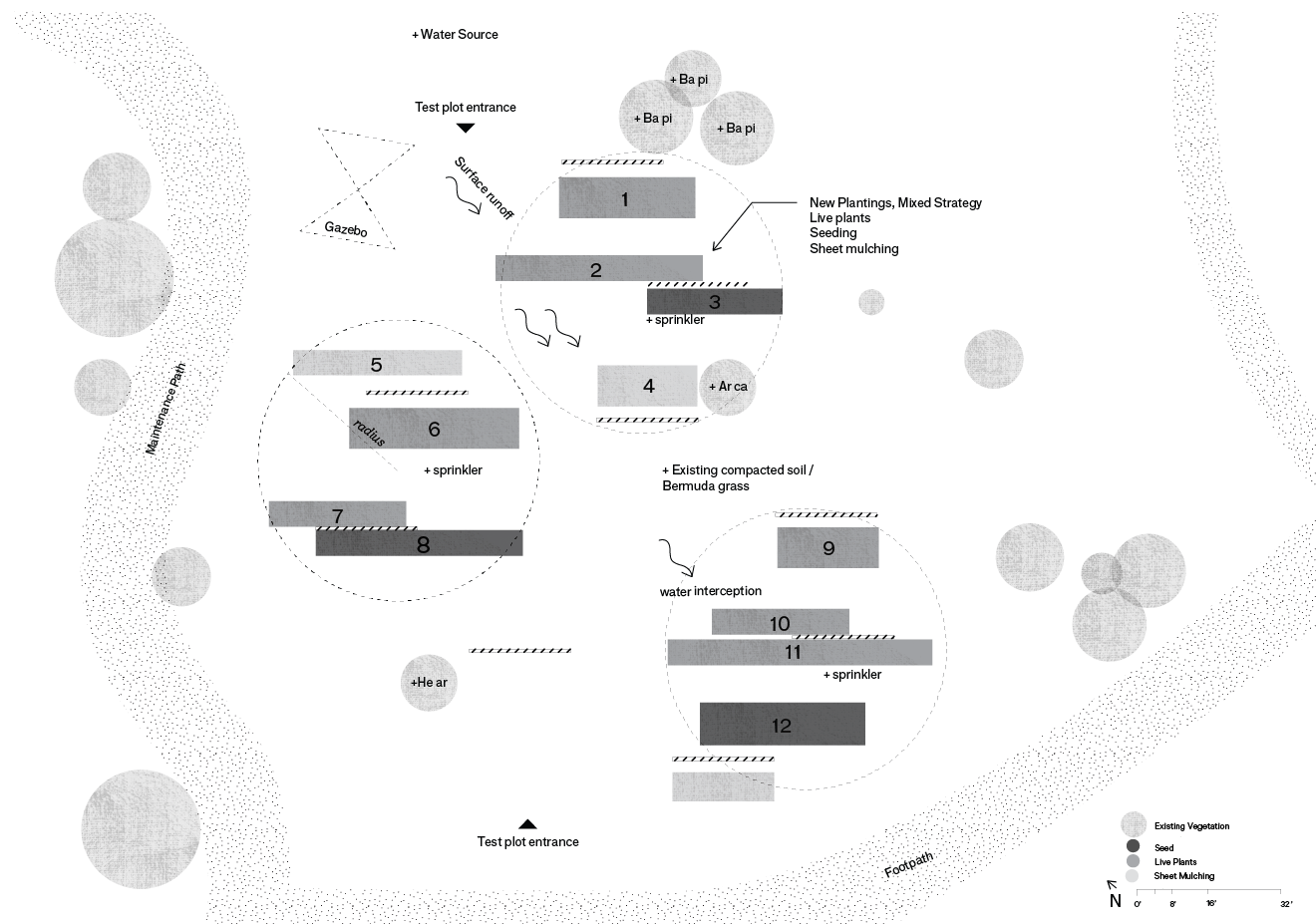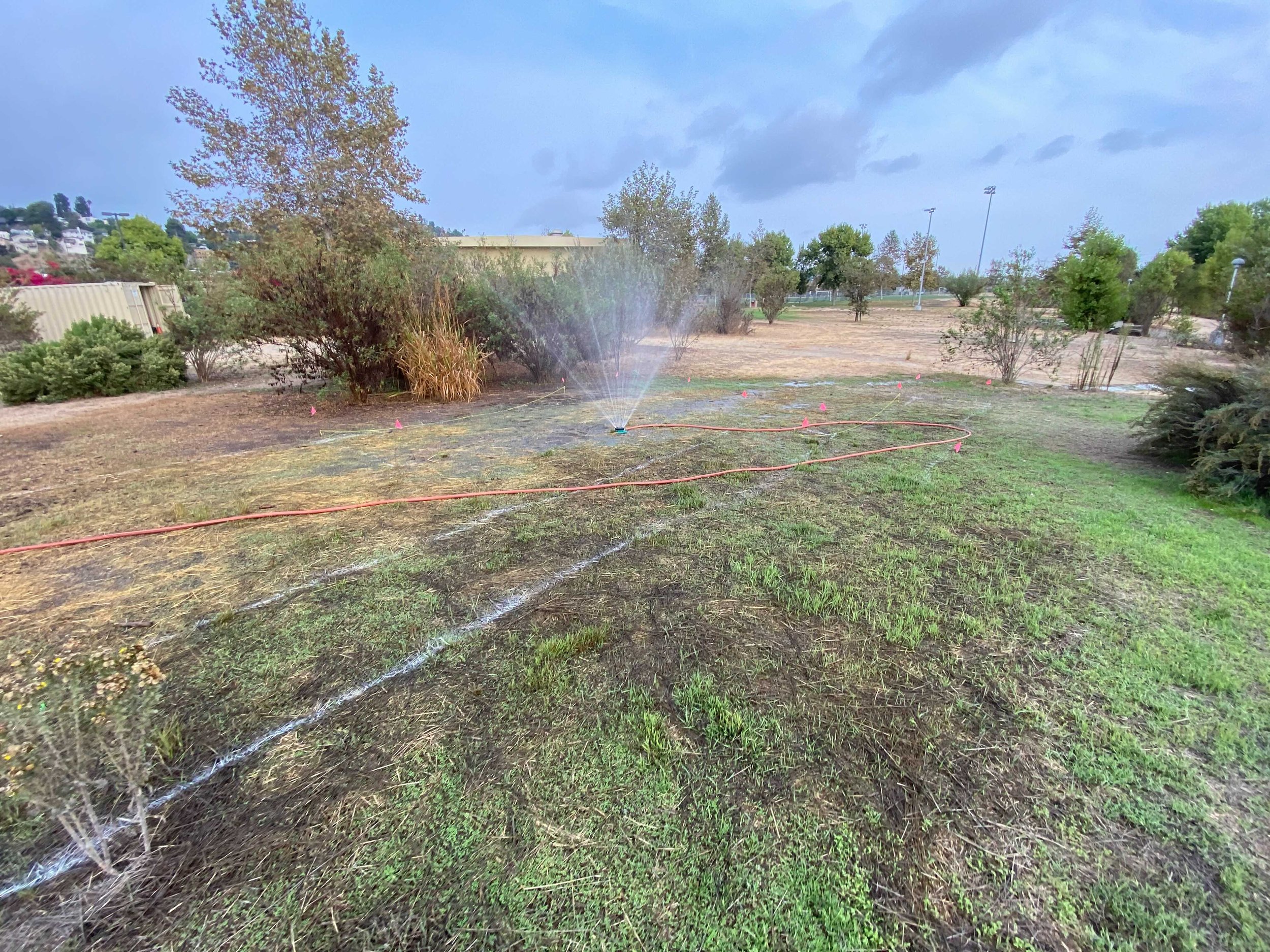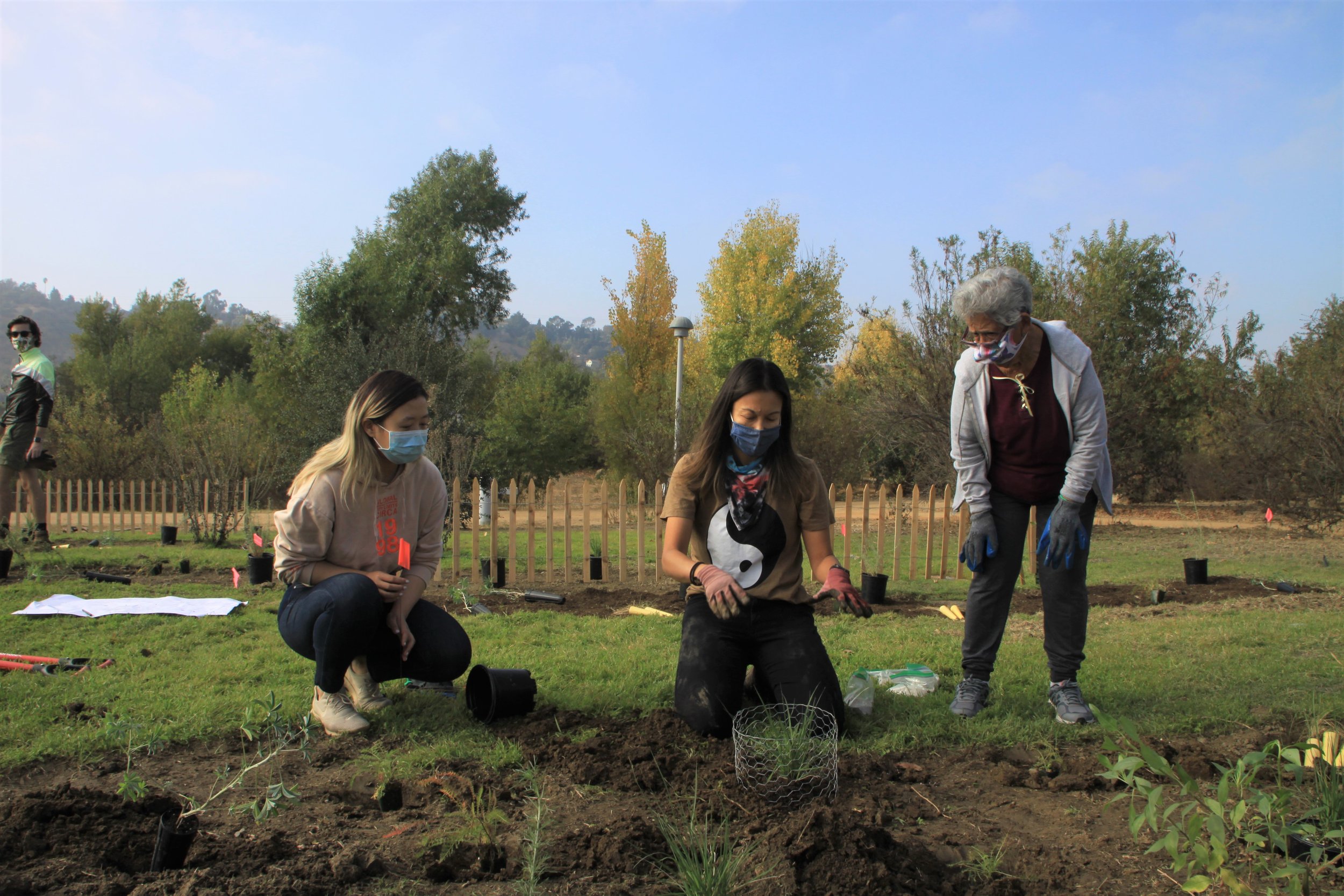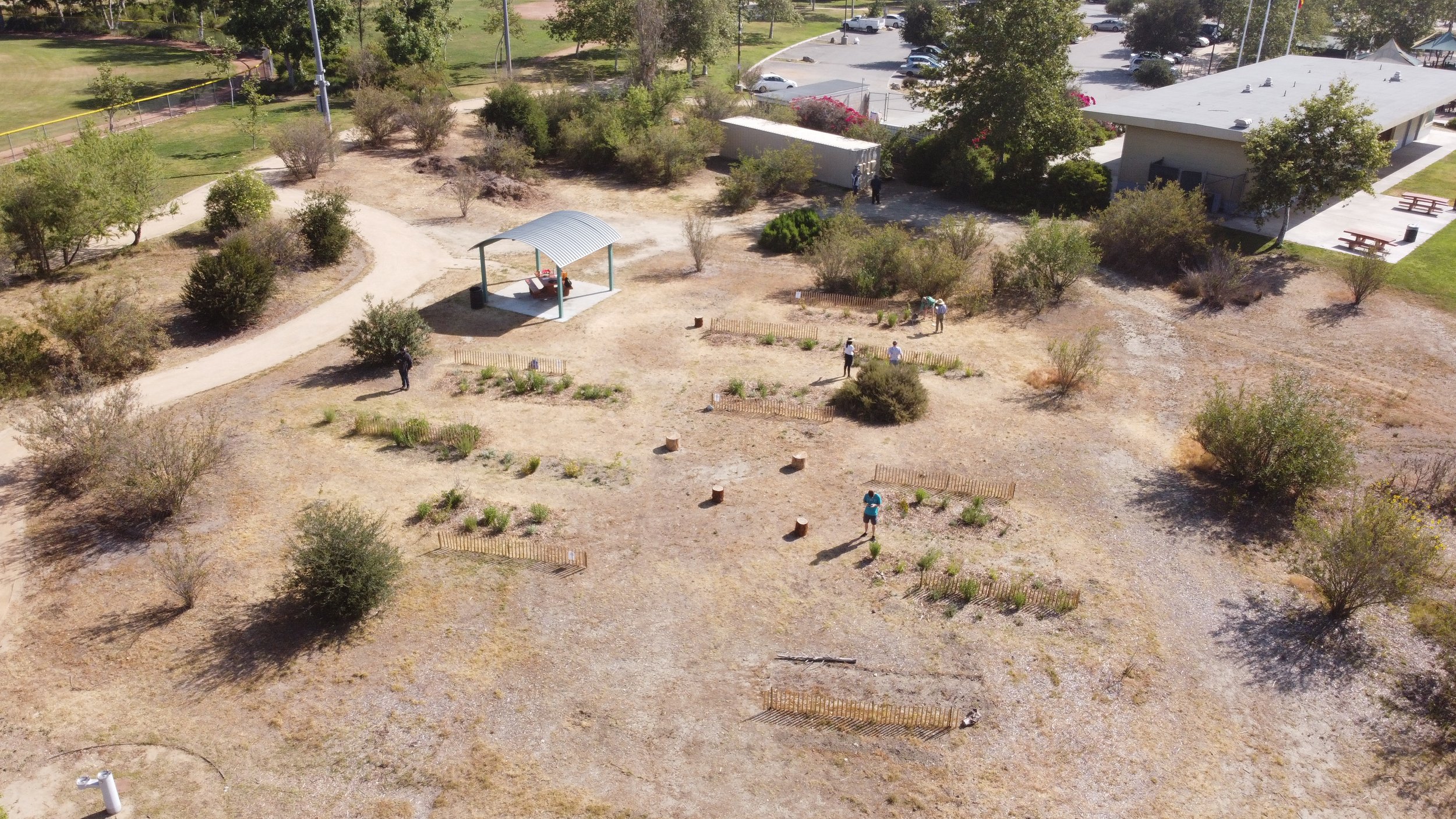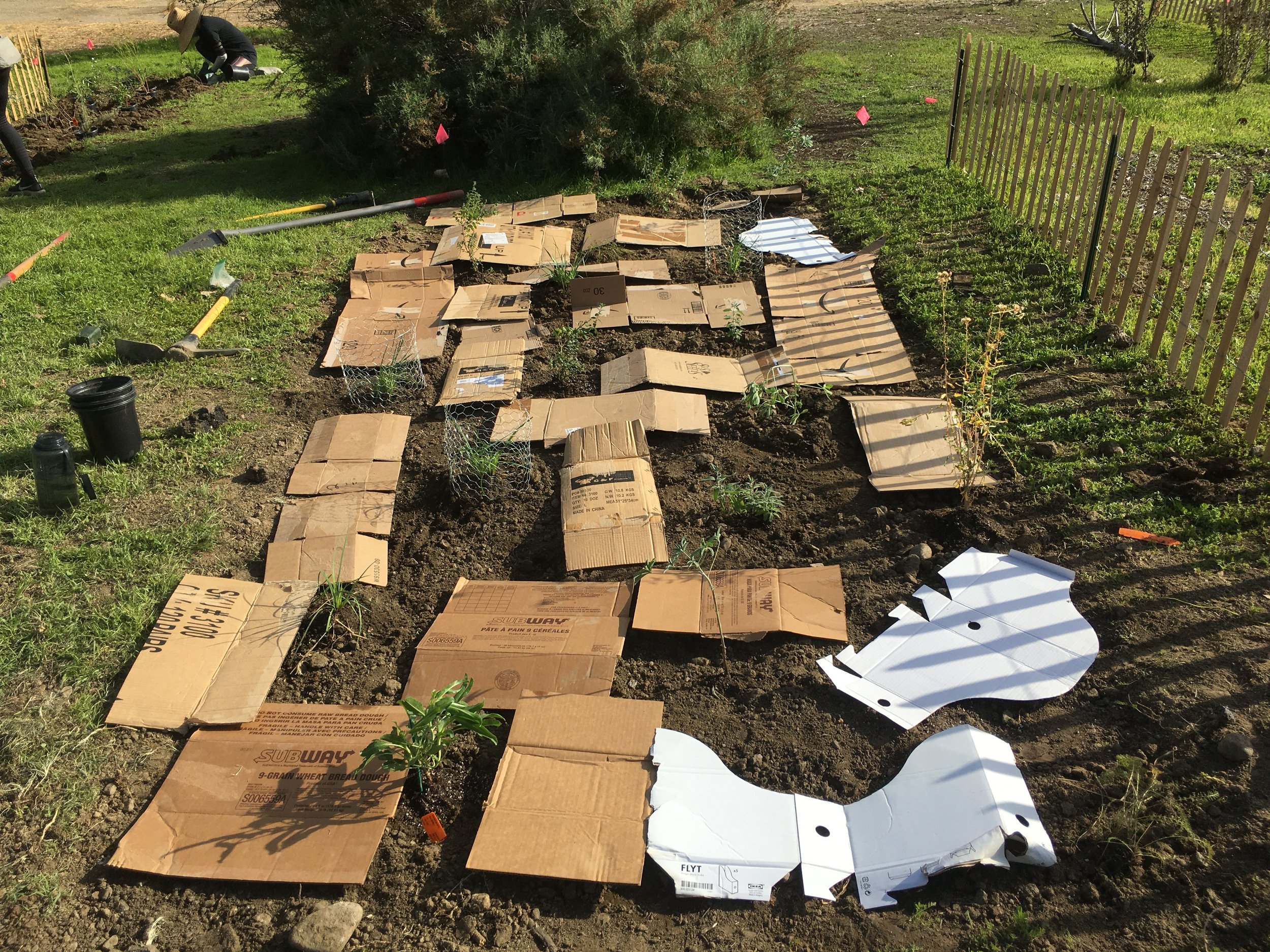Rio de Los Angeles Test Plot
A series of gardens on a former rail yard led by a group of abuelas
The Test Plot at Rio is one of several native habitat gardens that have been led by community members since the park opened in 2007. This plot is the second Test Plot site and was initially created as part of a design/build studio course in Landscape Architecture at USC in 2020. Our main question was: Can we replicate the Test Plot idea in a different location with a different community? In short, the answer was yes! Located in a transition zone between athletic fields, a picnic pavilion and restored riparian woodland, the footprint of the original Test Plot continues to expand and grow through volunteer efforts.
Rio Context (planted 2020)
THE TEST
The soils (urban fill) were heavily compacted, protected by a thin layer of bermuda grass, dried out from years of drought and heavy use, including maintenance trucks. We decided to test various soil building treatments including the use of mulch, compost as a top dressing, compost integrated into the top 6” of soil, and sheet mulching. We also tried live plants, live plants with seed, and seed only planting treatments. The linear bands are no more than 5’ wide, ensuring both sides can be accessed without stepping into the plots. The linear fence is a visual cue, rather than a barrier.
2024 UPDATE
Compaction still remains a key issue. The good news is that bermuda grass has not come back and the plants in the plots are doing pretty well. Tough species like Telegraph Weed continues to spread and thrive, but not much else has self sown or spread by rhizomes beyond the plots. Buckwheat is the only species that reliable grew from seed. We have concentrated our effort in the last couple of years on adding more habitat in the areas beyond the plots, since this particular area is so hard-packed. Given what we now know, if we could do it again, I would increase the grow/kill cycle time (maybe do it for 2 winters and wait for a really wet rainy season). I would also try methods to get water deep into the soil, like vertical mulching via an auger.
BACKGROUND
Rio sits within a narrow valley between Mt. Washington and the steep bluffs of Elysian Park on land that was once settled by the Tongva Indians, Spanish ranchers, and the First Transcontinental Railroad. In the 1920s, Rio and the area around it became Taylor Yard, a 244-acre railroad maintenance and operations facility which spurred the growth of the neighborhoods Glassell Park and Cypress Park but left the site soils heavily polluted from decades of industrial use. When Taylor Yard closed in the 1980s, it was divided into several different parcels for sale including Rio, which became a park after a diverse group of community organizations fought to turn the land into a park for the people. Rio opened on Earth Day 2007 and has since been managed by LA Rec and Parks (who take care of the active rec fields and facilities) and State Parks (who coordinate the care of the naturalized areas). Rio is part of a future network of LA River parks. Two other riverfront parcels next to Rio (G1, known as the Bowtie, and G2) are slated for development and together with Rio, could form nearly 100 acres of contiguous parkland - an important piece of the future revitalization of the LA River.
During Fall 2020, we were in the midst of a global pandemic. We thought, what a perfect time to expand the idea of Test Plot beyond Elysian Park. Could it work in other locations, with other communities? How would our approach need to differ in planting but also in stewardship? One of the reasons Rio is a special park is because it has people power! Since the early advocacy to transform Rio into a park for the community, it has drawn a strong base of volunteers. Many of the gardens in the park were community initiatives, from the bird and butterfly gardens and the artist's bench, to the scent “snake” garden and the scrub jay habitat. These are all maintained by groups of community volunteers from the Park Champions program, the Abuelas de Parque, and LA Audubon.
The people that participate in these groups are largely elderly and so we developed a maintenance schedule around a set time each week, for example on Monday mornings to do a bit of weeding after a morning walk and chat. In this way Test Plot seemed a natural continuation of the efforts already underway, and a chance to partner and learn from an already established volunteer program. Together with students from USC, we developed a design and installed the plants in November 2020. We asked questions like:
—To what extent should Test Plot engage with the public? —What is the role of a fence? Who is invited and who is excluded? —To what extent should the design engage with the site's history? —How far can we drag a hose, and how does that guide where we plant?
In 2022 the Taylor Yard pedestrian bridge opened to connect Rio and the Glassell Park neighborhood across the LA River to Frogtown and Elysian Valley. As this area of the LA River continues to develop into the 100 acre parkland, we hope Test Plot and the many examples at Rio can serve as a meaningful example for public engagement and community stewardship in ecosystem restoration.
PRESS
—Native Plants are Bringing New Life to L.A.'s Ravaged Areas, Los Angeles Times, November 2022
—Test Plots in Los Angeles Parks Grow More Than Native Crops: A Community of People Who Care, NEXT CITY, April 2022
—The Lab in the Backyard: USC’s Landscape Justice Initiative aims to give students grassroots perspective on their field, Landscape Architecture Magazine, April 2022
—The Future of Land Care in Los Angeles, USC Archtecture Exposition, Fall 2020.
PLANT LIST
TREES
Juglans californica
Quercus agrifolia
SHRUBS
Artemisia californica
Baccharis pilularis
Encelia californica
Eriogonum fasciculatum
Heteromeles arbutifolia
Isocoma menziesii
Malosma laurina
Mimulus aurantiacus
Rhamnus (Frangula) californica
Rhus integrifolia
Ribes aureum
Rosa californica
Salvia leucophylla
Salvia mellifera
Salvia apiana
Salvia spathacea
Sambucus nigra
SEED MIX
Acmispon glaber (Deerweed)
Achillea millefolium (Common Yarrow)
Baileya multiradiata (Desert Marigold)
Dichelostemma capitatum (Blue Dicks)
Eriogonum fasciculatum var. Foliolosum (CA Buckwheat)
Eschscholzia californica (CA Poppy)
Layia platyglossa (Tidy Tips)
Lasthenia californica (Goldfields)
Lupinus succulentus (Arroyo Lupine)
Penstemon spectabilis (Showy Penstemon)
Phacelia cicutaria (Caterpillar Phacelia)
Peritoma arborea (Bladderpod)
Mimulus aurantiacus (Sticky Monkeyflower)
Salvia columbariae (Chia)
Salvia mellifera (Black Sage)
Lupinus bicolor (Miniature Lupine)
Nemophila menziesii (Baby Blue Eyes)
Phacelia minor (CA Bluebells)
Sisyrinchium bellum (Blue-eyed Grass)
Stipa pulchra (Purple needlegrass)
LOG
TEAM
—Jen Toy, Lecturer, USC Department of Landscape Architecture + Urbanism
—Arch 642 Test Plot Class Fall 2020
Students: Robert Andrade, Siwei Chen, Hector Covarrubias Del Cueto, Lauren Cubacub, Shun Feng, Megan Gozini, Yiqian Lin, Jared McKnight, Yiyi Peng, Qingru Yang, Danielle Vonlehe, Wanting Zhou
—with support from Jenny Jones
PARTNERS
—Our fearless leader Luis Rincon, Community Engagement Coordinator, CA State Parks
—Tania Romero and Marcos Trinidad, Audubon Center at Debs Park
—California State Park Champions
—Abuelas del Rio
YEAR
—Nov 2020 initial planting
—March 2022 expanded plots into natural swale (failed)
—Spring 2023 expanded area for Least Bell's Vireo habitat supported by NFWF with Theodore Payne Foundation, Terremoto and Audubon Center at Debs Park
—2023-2024 Winter, urban superbloom (almost no germination)
MONITORING
—2020-2021: Colin Amos, Robert Andrade, Danielle Velazco, Danielle Vonlehe.
—2021-2022: Hannah Flynn
—2022-2023: Nina Weithorn, Danielle Velazco
—2023-2024: Jeremy Joo
THANK YOU
—Michael Martinez, LA Compost
—Los Nogales Nursery
—Theodore Payne Nursery
—Angel City Lumber for the amazing stumps, which they repurpose from fallen trees in LA (Ours specifically are Coldwater Canyon Coast Redwood & Sherman Oaks Canary Island Pine)
—Chesbro Tree Care (for the mulch)
